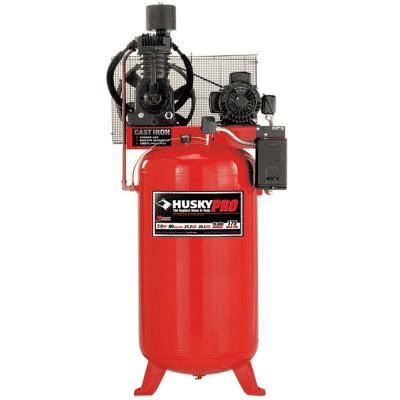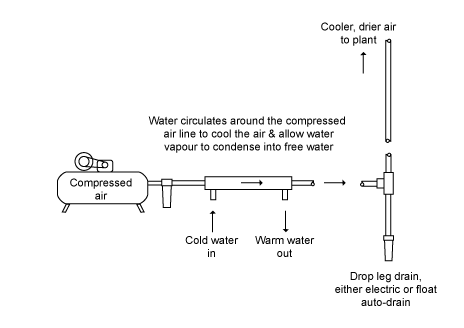Air compressor intercoolers are mechanical heat exchangers used to cool compressed air. This page will serve as a guide to provide you with all the relevant information on air compressor intercoolers!
Table of Contents
- What is an Air Compressor Intercooler
- How does an Air Compressor Intercooler Work?
- Intercooler Maintenance
- Air Tank Coolers
- Useful Reading
- FAQs (Frequently Asked Questions)
What is an Air Compressor Intercooler
If you simply understand that inter means between, and that cooler – well that’s pretty self explanatory isn’t it, then you get the gist of the term intercooler.
If you are inclined to enjoy a cold beverage drawn from a cooler on a hot afternoon while you are out in the sun, then you already understand the concept of what an intercooler does.
The process of compressing air elevates the air temperature, sometimes to quite high temperature levels. As air is compressed and driven into the compressor tank the temperature of the compressed air will rise. As the compressor runs longer, the air temperature will become hotter.
In order to deal with the increasing compressed air temperature an intercooler will often be installed in the line between the two cylinders to help cool the air before it is ingested into the next cylinder for further compression. The intercooler improves the compressor’s efficiency.
An intercooler is a mechanical heat exchanger used to cool compressed air back to near ambient temperature to increase their volumetric efficiency. Typically an intercooler will be able to cool the compressed air to within 20-30 degrees Fahrenheit of the ambient air temperature entering the system.
In a multi-stage unit compressor, the air is compressed in succeeding cylinders, getting hotter and hotter along the way. The “ribbed” air lines between cylinders and into the tank on the following Husky compressor are an example of a basic intercooler. The “ribbed” air lines offer more surface to the surrounding air, transferring heat from the air in the line to the atmosphere.

How does an Air Compressor Intercooler Work?
Intercoolers in multi-stage units may function through air cooling or water cooling.
Air Cooling
In air cooling the compressed air will pass through a chamber, on the outside of which, is substantially increased surface area – sometimes called fins – exposed to the ambient environment. The increased surface area will allow the heat inside the compressed air line to move more readily to the surface and to escape into an area of lower temperature.
These types of intercoolers work by allowing the compressed air to pass through a network of small tubes and cooling fins. Heat transfer then occurs where the hot compressed air passed through the tubes and transfers its heat to the cooling fins. The cooling fins are kept cool by a flow of ambient air temperature.
Water Cooling
Water cooling is achieved by passing the compressed through water-cooled heat exchanger(s), similar in concept to the one shown in this diagram.

In short, cool water will flow around the outside of the air line, quickly taking heat away, and cooling the compressed air rapidly.
The cooling process is initiated when cool water is fed into the intercooler and through its tubes. The tubes have fins attached to them to add stability and aid in increasing the cooling surface area.
Note: utilizing larger diameter tubes will allow you to have greater cooling surface area. e.g. using 3/8″ tubes instead of 5/8″ tubes.
Moisture from the lower velocity air condensates and then separates from the air as it passes through the intercooler towards the end. The moisture can then be drain from the compressor at the bottom of the intercooler enclosure through a valve. The cooled air with its reduced moisture then passes through the next stage of compression where the intercooling process is repeated.
This method of removing the moisture from the air compressor system prevents the loss of valuable compressed air, whilst also increasing the overall efficiency of the compressor by not having to compress the entrained water moisture that is removed during its process.
Not only this, but it helps reduced erosion to the compressor parts like the impeller (depending on the design) which results in the maintaining the compressors performance long-term.
Intercooler Maintenance
It is vital that intercoolers are maintained and kept clean on air compressors. They tend to be provided so that they’re easy to inspect and clean by removing the entire shell from the unit. Regular inspections can help reduce the amount of fouling or debris found within the intercooler, which itself will cause corrosion or varnish of the compressors parts.
You do NOT want to operate with dirty intercoolers.. this will increase the risk of higher air temperatures and reduce the air density during compression. As well, pressure may rise to surge and negatively affect both the efficiency and capacity of the air compressor system.
Air Tank Coolers
Consider also that the air receiver, that tank that stores your compressed air before use, and that is located between your compressor and your plant air lines, is also an intercooler of sorts.
The longer the air sits in the compressor tank before use, the cooler that compressed air will get, and the more condensation will take place in the receiver.
That, and frequent draining of collected water through the tank auto drain or manual tank drain, will prevent this condensed water from entering the downstream airline, benefiting all downstream air components that are negatively affected by water.
Useful Reading
Air Compressor Aftercooler Guide to Compressed Air Coolers
Air Compressor Heat Exchanger Guide
Intercooler vs Aftercooler In Compressed Air System
FAQs (Frequently Asked Questions)
The purpose of an intercooler is to cool the compressed air back to a temperature near ambience so that the volumetric efficiency increases. This can also help maintain the compressor parts for a longer duration due to
An air-to-air intercooler works by passing the compressed air through a network of small tubes past a number of cooling fins. The hot compressed air passing through the intercoolers tubes then transfers its heat into these cooling fins, which in turn are kept cool by the flow of ambient air around them.
Intercoolers and aftercoolers are forms of heat exchangers used in air compressors to cool compressed air (which naturally gets hot) to protect your system and deliver the highest quality of air to your end devices. An aftercooler operates by cooling the air emerging from a compressor unit whilst an intercooler is a device that cools the air before it’s intake or between cylinders in multi-stage systems.
If you have any questions about air compressor intercoolers please leave a comment below with photos if applicable so that someone can help you!
